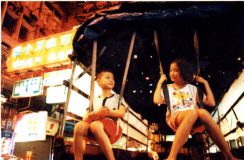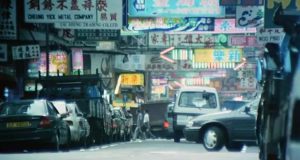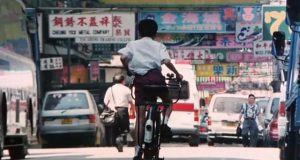Youtube link: https://youtu.be/lRheqQS1OPg
Script:
Chan: Hi! My name is Tony!
Tyler: And my name is Tyler Vu!
Chan: By the way, Tyler, did you decide where we were going today?
Tyler: Not quite! There were just too many options for me to choose from. I was walking through Portland Street and was just overwhelmed with the amount of signs from all around! It’s like each store was calling to me, trying to pull me in.
Chan: Ahh yes, I understand where you are coming from. Portland street has such a rich history and is a great representation of the constant evolution in Hong Kong. I think I was watching the 1999 film “Little Cheung” by Fruit Chan and saw Portland Street over two decades ago, and the changes from what we see today are pretty drastic.
Tyler: Yeah, I mean Portland street used to be famous for its bright neon signs that would light up the sky. It was even overwhelming at times, but to do modern reform, these neon signs are almost extinct.
Chan: I think I was able to count all of the neon signs left on the street with my fingers! That’s quite a difference when you compare to the hundreds of neon signs that used to be there.
Tyler: I agree. I think that used to be one of the most iconic views of Hong Kong and definitely was a huge factor in contributing to the relation of the word “cyberpunk” with the city of Hong Kong. Additionally, it followed tradition for a sign to carry the soul of a business as shop owners passed their business through generations.
Chan: I mean besides even the neon signs, there are many other signs that litter Portland Street. For example, some of these “older signs” like these posters or wooden boards will also soon be replaced as the city continues to become “more modern”.
Tyler: Yeah, that is an interesting perspective. It’s quite common for us to talk about neon signs, but never quite the other signage along the street.
Chan: I think one of the huge things that I noticed while walking from Yau Ma Tei station to the northern end of the street was how it felt as if we were teleporting through time. If you notice, at the most southern end of the street, the signage still feels old and classic. You have a lot of local restaurants and services along these streets. However, the further you walk up the street, the more gentrified it becomes. You begin to see huge malls with modern led signs that are used in exchange of those wooden signs.
Tyler: So I guess this begs the question of why these signs are disappearing?
Chan: I mean I mentioned it a bit previously, but I can elaborate now. The neon signs we mentioned at the beginning are known to be disappearing due to government issues policies that date back to 2010. These policies usually called for shop owners to remove and install new ones but then required them to retrospectively have them approved. Furthermore, less than 50% of the applications are granted, so most of the owners rather remove the signs and replace them with LED variants instead. As for the other signs along the street, we will continue to see less of these wooden and paper signs along the street due to gentrification and the constant increase of living within the area. At the northernmost part of the street is where a new modern mall has been put into place, it is very likely we will see this modernization trickle down the street.
Tyler: Yeah, that’s a great point. Building off of that, this development will continue throughout the street and may lead to higher living costs which will in turn push out long-term residents and small business owners. This is never a good circumstance, especially when it comes to locals within the area that have been there for generations. While on one hand, they may be happy for the attention and growth of the neighborhood near them, those feelings may turn sour when it affects their way of living and eventually push them out of the neighborhood.
Chan: Hopefully, that is a circumstance that will not actually come to fruition. Ways we can combat this is through initiatives to support local businesses and careful urban planning. Initiatives to support local businesses cannot just only increasing the amount of people that come into these businesses, but also include grants or rent subsidies for traditional businesses. Urban planning is helping to ensure that new projects that are brought along are focused on improving the lives of current residents rather than displacing them for commercial gain.
stills: 




Work distribution:
Chan Ka Chun (3036086945): editing
Tyler Van Vu (3033116804): script writing